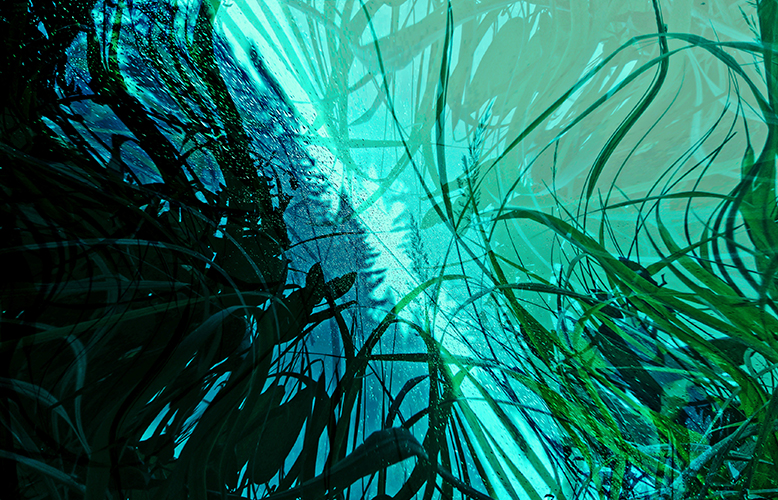(Artwork above: Submerge 4)
Growing up in Minnesota, Bend artist Patricia Clark was surrounded by water. In “the land of ten thousand lakes” water was a dominant presence in the landscape and a way of life. Summers were spent swimming, fishing, canoeing on placid lakes. But water could also gather shocking force. Clark’s otherwise happy childhood was marked by the painful memories of the Red River flooding her family home—not once, but twice. Her relationship with water deepened.
As Clark began developing her marks and artistic language, she created “mappings” of her native state. She registered the contours of the land, noted the depths, drew grids and marked the water.
Fifty years later and settled in Bend, Clark felt the acute absence of water in the high desert. Droughts and forest fires sharpened her awareness of water issues. Her curiosity led her to study the water table—the top plane of our vast underground aquifers. Over the last five years, the water table has continued to feed Clark’s work, culminating in two exhibits.
Bend Art Center’s Water Tables exhibit features mixed-media works by Patricia Clark. Her clayboard pieces include smudges of charcoal and layers of pencil, ink and watercolor. A master printmaker (and founder of A6 Print Studio), Clark also carved marks into the clayboard surface, giving each piece the quality of an etching or relief plate.
Clark enlisted six colleagues (current or former Central Oregonians) to join in the exhibit: encaustic artist Barbara Hudin, photographer Carol Sternkopf and local sculptors Abney Wallace, Ron Schultz, Bill Cravis and Christian Brown.
Hudin’s pieces reflect the blazing sun and baked earth in the shocking demise of the Salton Sea, once the largest lake in California. Sternkopf’s blue and green saturated photos look as though they were shot underwater, looking upward through the surface of a lake. In fact, Sternkopf’s photos are an amalgamation of images digitally layered and colorized to create water where there was none.
The four sculptors of Water Tables were given a novel assignment. Clark purchased four wooden tables from IKEA, doling them out to each artist as a starting point. Wallace chopped his table into wooden shards, arranging them in an open, rock-like pattern on an oil-black plane for his “Fracking Table.” Cravis’s table is transformed into a floating iceberg, with water-rippled legs and a painted blue sea backdrop, and two miniature figures perched on the sharp point of ice. Brown’s table is laminated in a variety of plastic shopping bags, with saw-dust filled water bottles arranged on the table top—a commentary on plastic’s infiltration into the environment and the degradation of our water supply. Schultz’s table combines aspects of earth, air, fire and water, and serves as an homage to “the Green Man,” a symbolic figure of regeneration.
Clark’s copious sketches and smaller mixed-media works were curated for Water Tables: Sketches, on display at COCC’s Barber Library through November 27.
Both Water Tables exhibits inspired a bevy of talks, classes and a school program exploring water’s presence, absence and importance in Oregon’s high desert.
Several partner organizations planned programs connected to the Water Tables exhibits. Scalehouse will present Disparate Voices, an exploration of the Oregon landscape, water and the impact of climate change with Water Tables artist Patricia Clark and USGS Geologist Jim O’Connor. Part of the “Scalehouse Voices” series, Disparate Voices will be held at OSU-Cascades on Wednesday, November 7 at 6pm.
Bend Art Center is also offering several community classes inspired by water tables, as well as a school program which uses the Water Tables exhibit to teach students about local hydrology.
Find details online at bendartcenter.org/water-tables-program-guide or call Bend Art Center at 541-330-8759.

